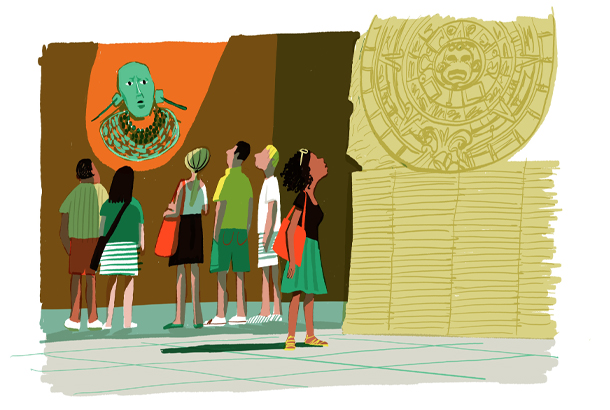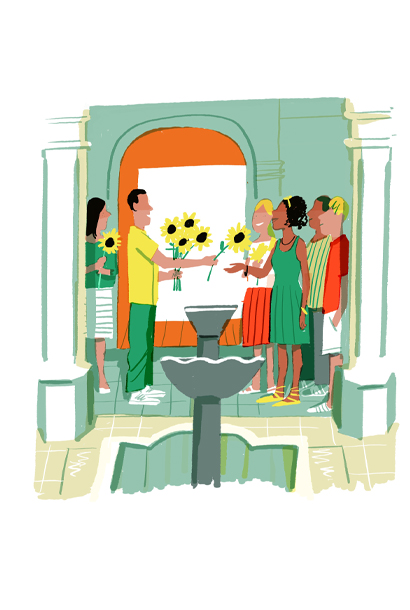A visit to Mexico City helps a hesitant Spanish speaker untie her tongue
“There are only two reasons you’ll ever learn a language—because you really love it or because you really need it,” says Pachi, my Spanish coach, who happens to speak four additional languages. I stare blankly at him as the afternoon sun streams through the window of our two-person classroom. I’m in the third of my four hours of instruction for the day, midway through the intensive, week-long Fluenz Spanish language immersion program in Mexico City. To put it plainly, my brain has hit a wall.
I sit there, pondering his statement. Do I need Spanish? As a resident of Washington, D.C., the simple answer is no. Do I love it? Well, that’s a bit more complicated.
I can still remember coming home from pre-school and counting to 10 in Spanish on my tiny fingers for my impressed parents. From that point on, mastering the language became something of a low-simmering obsession. As a kid in Arlington, Virginia, in the 1990s, I learned from teachers who spoke and taught us Spanish, and my friends reflected the wide swath of Latin American immigrants in the D.C. area.
In middle school, a Spanish teacher flipped my language-learning world upside down. He incorporated Spanish into my classmates’ daily lives and, more importantly, into pop culture. We listened to Ricky Martin and Shakira before they burst onto the American music scene, and we learned all the words to “La Copa de la Vida” before watching the 1998 FIFA World Cup. It was the first time Spanish felt alive to me—not just something in a workbook. Five years after college, I spent a year in Madrid as an English language assistant in a public high school. That’s when speaking Spanish clicked in a way it never had before—because I truly needed it. At first, my brain was exhausted, my speech clunky. Then I started dreaming in Spanish. I began to forget English words. The highlight of my entire year was when an elder señora asked me for directions, and I replied to her in Spanish without carefully translating my words. I was hooked.
Until I wasn’t. After I moved back to the States, life got in the way. In addition to losing some of my Spanish-speaking skills, I lost my confidence. While living in North Carolina, I briefly tried attending a meet-up group for those wanting to practice their Spanish at my local library, but although I could understand the conversations around me, I felt too tongue-tied to speak. Craving a more international experience—including language-learning opportunities—I moved back to D.C., but it simply didn’t happen. I never took the opportunity to order in Spanish at Latin American restaurants, didn’t watch television shows in Spanish. Unintentionally, I settled back into a single-language life. My Spanish vocabulary never left me, but the ability to express myself confidently in complete sentences did.
By the time the pandemic hit, it had been six years since my Madrid sojourn. Like many others during that weird, isolating time, I tried the language-learning app Duolingo and listened to Spanish-speaking podcasts to brush up on my skills, but nothing stuck. I knew that if I wanted to regain the Spanish I had lost, I needed to be immersed.
As the world reopened to travel, a few of my friends booked long stays in Mexico City, opting to wait out the continuing pandemic in a country whose doors never closed to Americans. Though I knew nothing about the city, I remembered that my favorite online yoga teacher, Adriene Mishler of Yoga with Adriene, had led a yoga and Spanish immersion program there to help her connect with her Mexican heritage. After some creative Googling, I found her language instruction partner: Fluenz.
Sonia Gil and Carlos Lizarralde started Fluenz in 2007, and although the company has grown from a self-learning platform to now offer Spanish immersions in 10 cities across five countries, I wanted to start in its original location. Mexico City has hosted Fluenz students and teachers since 2018, and the program is a well-oiled machine, complete with a six-night stay at the Pug Seal Anatole France hotel in the chic Polanco neighborhood, a seven-course private dinner with wine pairings at the world-famous restaurant Pujol, a private evening visit to the National Museum of Anthropology, and, of course, daily classes. Best of all for me, there were openings for the spring immersion sessions. I booked a flight.
When I arrive at the airport in Mexico City, there’s a driver waiting to whisk me off to the Pug Seal. I briefly consider starting a conversation in Spanish about the city with him, but because of my internal panic I stick to a comment about the music on the radio: “Me gusta Bad Bunny.” We share a laugh, which helps me relax. I’d been steadily practicing at home on the Fluenz app (an immersion course grants you lifetime access), and the digital class on ordering in a restaurant comes in handy that night, when I dine solo at La Única, a lively indoor/outdoor restaurant in Polanco that specializes in cuisine from northern Mexico and the Pacific coast. Determined to order in Spanish—even though most of the staff speak English—I stumble through, only receiving one dish I don’t quite recognize.
Bright and early the next morning, I meet my 12 Fluenz classmates over chilaquiles and breakfast tacos at the hotel. Cofounder Carlos Lizarralde introduces the coaches and gives us a warning: “Learning Spanish is like a telenovela,” he says. “You’re going to experience all the emotions: happiness, betrayal, sadness, and frustration. You have to trust the process.”

Nervousness is the first emotion I experience, but I soon realize it’s not warranted. Walking the few blocks over to class, I speak Spanglish with my student partner for the week, Melissa, a lovely grandmother from Tennessee whose skills are impressive thanks to her months-long practice on the Fluenz software. I’m comfortable speaking in the present tense, but I start to struggle when we take our seats in the classroom and dive into preterit and reflexive verbs. Our exercises include listening to paragraphs of audio in Spanish and then filling in the blanks in a written version of the same paragraph, or taking the subjunctive versions of verbs and using them in a sentence with a correct conjugation. My brain is spinning as I scribble notes, but thankfully our Venezuelan coach, Camila, allows us to ask questions in English as the new information settles into our brains.
My apprehension shifts to excitement during that first class. Verb tenses and vocab words are coming back to me, and I feel myself finding the flow of the language. By the time we get back to the hotel for lunch, I’m so confident I opt to sit at the Spanish-speaking table instead of the English-speaking one. I immediately realize this is a mistake, however, as I struggle to follow the conversation around me. I make a mental note to give my brain ample breaks during the coming week.
The language really starts to come alive for me that night, when, over tequila and tamales, Mexican writer and cultural critic Adrián Pascoe gives a presentation about the country’s history, focused especially on Mexico City, the largest and oldest city in the Western Hemisphere. He breezily takes us from the founding of the Aztec Empire in 1325 to Spanish colonization to the election of the current president, Andrés Manuel López Obrador. Although there are English subtitles for the talk, I find myself understanding much of the Spanish. Cue my next telenovela emotion: happiness.
Each day, my fluency improves, but my main stumbling block is the use of demonstratives—this, that, these, those—which in Spanish have masculine, feminine, and non-gendered forms. These words summon the next prophesied telenovela emotion: betrayal. My brain simply refuses to register the proper usage of these words, even though I find myself easily discussing my favorite movies and books and picking up Spanish colloquialisms from my Madrid-born coach, Pachi. Finally, on the fourth day, while in class with Melissa and Pachi, I correctly use the non-gendered form of these; we all cheer.
My success with the course gets me curious about Fluenz’s beginnings. Over brunch at Cafe Toscano, Sonia Gil tells me the story. The program, it turns out, grew out of the Venezuela native’s own failed attempt to pick up French using Rosetta Stone. “The methodology didn’t work for me,” she recalls. “How do I go from looking at pictures and hearing phrases to actually knowing what’s going on?” She and Lizarralde set out to come up with their own method.

For research purposes, they traveled to Shanghai to do a two-week immersion in Mandarin, a language with which neither of them had any experience. “There were 10 of us in an office building in class for six hours a day, and after the first week, we couldn’t really say much,” Gil remembers. “I could say things like ‘My boss is an engineer,’ but I couldn’t go down to the café and order.” She ended up staying in China for an additional six months, determined to both understand Mandarin and learn a better way to teach a language. She moved to Guangzhou, wrote her own lesson plans in English, and hired two private tutors to teach her the lessons in Mandarin. This became the blueprint for both Fluenz’s online program and its immersion experiences.
“Many language-learning companies don’t adapt their lessons to the native language of the student,” Gil says. “What’s unique about Fluenz is that our program is specifically for English speakers, which means that our team is deeply knowledgeable about both the language you speak and the language you want to learn. We can break down your new language from the English point of view.”
For Gil, cultural education is a major part of learning a language. On both the app and Zoom immersion experiences, students are given recommendations for foreign films and invited to participate in virtual cooking classes, yoga sessions, and history talks—all in their new language The on-site immersion program sets up cultural experiences each night, to help attendees gain a deeper understanding of the city and its people.
These outings are also a major highlight of the week. At Pujol, which ranks 13th on this year’s World’s 50 Best Restaurants list, we sample chef Enrique Olvera’s signature Mole Madre, a complex, rich mole sauce aged for 3,037 days. Even more astounding is our private, after-hours tour of the National Museum of Anthropology. Our guide, Jacinta Cámara, breaks down Mayan and Aztec history and art, showing us everything from pottery to jewelry to the enormous sunstone, which was used as a sacrificial altar. The intricate jade death mask of the Mayan king Pakal the Great stops all of us in our tracks; discovered in 1952 on an archaeological dig in Chiapas, it was stolen from the museum on Christmas Eve, 1985, and was lost for nearly four years before police found it in the Mexico City home of one of the thieves. Cámara shares this information entirely in Spanish, and I somehow absorb all of it.
On our final day of classes, we convene in the Pug Seal’s courtyard and give 90-second presentations in both English and Spanish on a topic of our choosing. One of my classmates shares an account of whale-watching in Cabo San Lucas, while another performs a rap she wrote that includes a line about each student in our cohort. Inspired by a discussion about our favorite movies in class earlier that week, I give a scathing critique of the true villain in one of my favorite films, The Devil Wears Prada. (I mean the boyfriend, not the couture-clad boss lady.) When we finish, Chris, a fellow student, walks into the courtyard with his arms full of sunflowers and hands them out to everyone. I’m moved to tears.
Not ready to head home quite yet, I decide to stay a few extra days to explore Mexico City on my own and continue practicing my Spanish. Popping in and out of Ubers, I notice a shift: I no longer have a problem engaging in casual conversation with the drivers, telling them where I’m from and what I’m doing in town. On my ride to the airport, I even stun myself by making a joke in Spanish about the traffic. When the driver laughs, I feel an emotion not on the telenovela-inspired list: pride.
I also feel determined—both to keep learning and to come back to Mexico City. Maybe I don’t technically need Spanish, but this week has helped me discover, once again, that I do love it.




